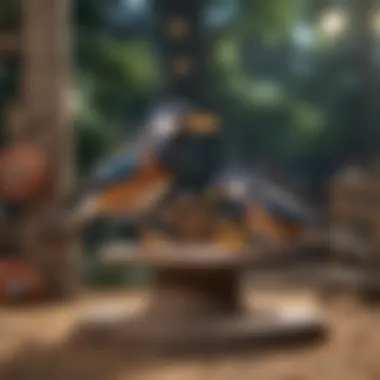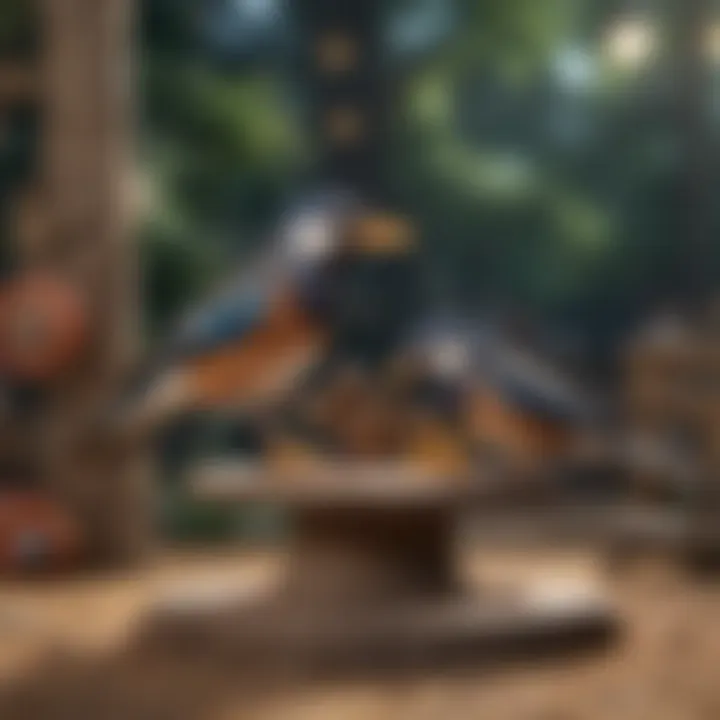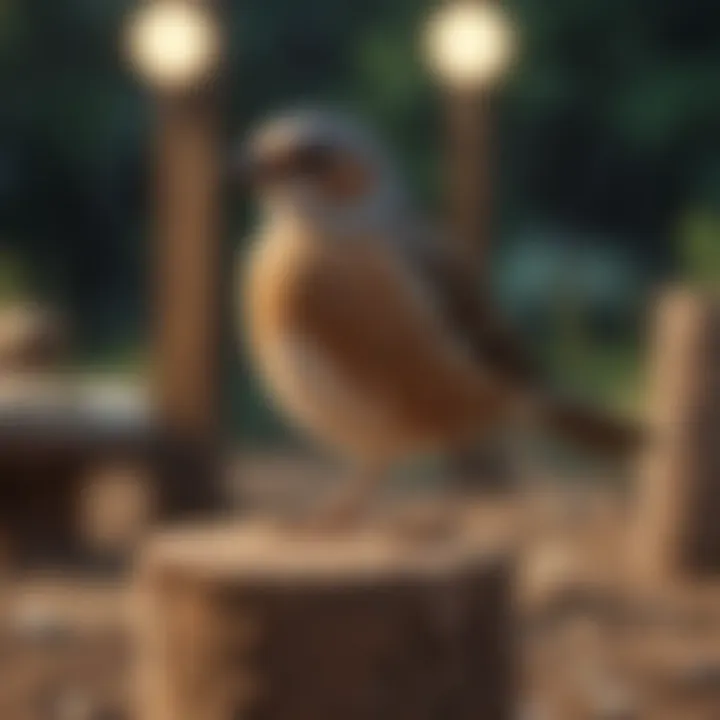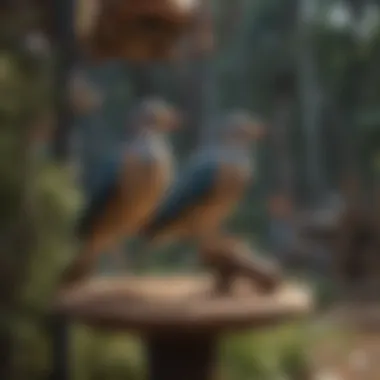Enhancing Avian Lives: The Role of Playground Stands


Intro
Birds, often seen as just delightful pets, require more than mere food and shelter to thrive. The emotional and physical health of pet birds hinges on their environment, and bird playground stands serve as an essential component in enriching their lives. This article will discuss how these structures not only keep birds engaged but also offer insights into aspects like behavior, health, and overall well-being.
Understanding Your Pet
Pet Behavior Basics
Understanding bird behavior lays the foundation for effective pet care. Birds are inherently social creatures, predisposed to exploration and play. Their need to interact with their environment mirrors instinctual behaviors found in wild settings. A well-designed playground stand can mimic these instincts, allowing pet birds to climb, swing, and explore, thus preventing boredom.
Common Breed Characteristics
Different bird breeds express unique behaviors. For instance, parakeets are known for their playful nature, while cockatiels tend to be more vocal. Recognizing these traits can help owners select appropriate playground stands that cater to their birds’ preferences. It’s crucial to match the stand’s features—such as the type of materials and structures—to the species characteristics.
Species-Specific Needs
Species-specific needs vary widely. A conure may prefer more hanging toys to chew on, while a canary may appreciate open spaces for flying. Paying attention to these differences ensures that the playground stand crafted for them can serve the widest array of activities, encouraging natural behaviors.
Enrichment and Activities
Indoor vs. Outdoor Activities
Both indoor and outdoor time benefits birds significantly. Indoor playground stands can be designed with a variety of textures and heights, fostering physical activity in a safe environment. Outdoor activities, like supervised time in a aviary, expose birds to fresh air and natural stimuli.
Interactive Toys and Games
To further enhance enrichment, consider integrating interactive toys with the playground stand. For example, foraging toys can stimulate a bird’s natural curiosity and problem-solving skills. These toys can be built into the stand to make playtime more engaging.
Socialization Opportunities
Birds are social by nature, and interactions with their owners or other birds are crucial. A playground stand not only serves as a play area but can also facilitate social bonding. This interaction helps in building trust and familiarity between the bird and owner, thus promoting overall emotional health.
"Enrichment activities that encourage birds to engage with their environment contribute to healthier, happier pets."
End
Bird playground stands represent more than just a physical structure; they symbolize a commitment to the enrichment and well-being of pet birds. Understanding specific behaviors, characteristics, and needs allows owners to create fulfilling environments that cater to their pets’ instincts. Through thoughtful engagement and consideration of their avian friends’ welfare, pet owners can truly elevate their birds' lives.
Preamble to Bird Playground Stands
Bird playground stands play an essential role in the enrichment and well-being of pet birds. Understanding their significance can help pet owners create a stimulating environment that enhances both physical and mental health. These stands provide opportunities for exercise, socialization, and cognitive growth, helping to combat common behavioral problems seen in captive birds. In this article, we will delve into the details surrounding bird playground stands, focusing on their definition, historical context, types, materials, benefits, and maintaining these structures.
Definition and Purpose
A bird playground stand is a structure designed for pet birds to play, exercise, and explore. The term encompasses a variety of designs and can include perches, toys, and accessories that simulate natural habitats. The main purpose of these stands is to promote physical activity and mental stimulation, counteracting boredom and sedentary behavior. By providing engagement, birds can express natural instincts, reducing stress and enhancing their overall quality of life. It is crucial to select a playground that meets the specific needs and preferences of the bird, ensuring that it serves both as an entertainment hub and a safe haven.
Historical Context of Bird Playgrounds
Historically, the concept of bird play areas is rooted in the understanding of animal welfare. As studies began to reveal the needs of captive birds in the 20th century, the importance of environmental enrichment became clear. Early on, bird owners often relied on basic cages and limited toys. Over time, however, there was a shift towards more holistic approaches to avian care. This led to the development of specialized playgrounds tailored for birds. In recent years, awareness of avian needs has surged, with playground stands now widely regarded as essential for enriching the lives of pet birds. This evolving understanding has encouraged manufacturers and enthusiasts alike to create innovative designs that further enhance the avian experience.
Types of Bird Playground Stands
The category of bird playground stands is essential in understanding how these structures contribute to avian enrichment. Each type serves unique purposes, benefiting both birds and their owners. When choosing a stand, factors such as space, intended use, and bird behavior must be considered. Recognizing the characteristics of various stands can enhance the quality of life for pet birds in different environments.
Indoor vs. Outdoor Stands
Indoor stands generally offer a stable environment for birds to engage with their surroundings. They can be tailored to fit within the home aesthetic, allowing for easy integration into daily life. Most indoor stands are made with safety in mind, featuring smooth edges and non-toxic materials. Indoor playgrounds often include perches, toys, and exploration areas to stimulate the bird’s mental activity.
On the other hand, outdoor stands provide unique benefits that cannot be replicated indoors. Fresh air and natural sunlight are important for the health of many bird species. Offering an outdoor experience allows birds to engage with their natural instincts. Potential dangers, such as predators or harsh weather conditions, should be carefully assessed when using these stands. The right equipment enables birds to enjoy outdoor enrichment safely, promoting a well-rounded lifestyle.
Portable Playgrounds
Portable playgrounds are designed with mobility in mind. They offer flexibility for bird owners who want to engage their pets in various settings. This type of stand allows for a change of scenery, which can be beneficial for birds who easily get bored. Some portable stands come with wheels, making them easy to move from one room to another or even outside.
Using portable structures means birds can experience different environments while staying safe. The varied settings encourage exploration and promote mental agility. However, it is crucial to ensure that any portable stand is stable enough to prevent tipping during use. Proper construction should include a low center of gravity and secure fastening options.
Custom-built Environments
Custom-built playgrounds offer a personalized enrichment experience tailored to specific bird species and owner preferences. These stands can incorporate specialized features that attract particular birds. For instance, a custom playground may include different levels for climbing, various textures, and a range of toys. Customization enables owners to address their birds' individual needs effectively.
Creating a custom environment also allows owners to make changes based on their observations of bird behavior. If a bird shows interest in certain activities, the stand can be adjusted to facilitate that curiosity. Owners can selectively include items that align with their pet's preferences, enhancing the overall enjoyment and engagement. While these installations may involve more effort and investment, the resulting benefits can lead to increased bird satisfaction and well-being.


"Providing suitable playground options is key for bird health and behavior. The emphasis should always be on safety, usability, and enrichment."
Materials Used in Bird Playground Stands
The construction of bird playground stands plays a crucial role in their effectiveness and safety for avian companions. The choice of materials is not simply about aesthetics; it directly influences the stand’s durability, safety, and overall functionality. Choosing appropriate materials is essential for creating an engaging and secure environment for birds. Pet owners must consider several factors, including the potential health risks associated with certain materials and how well they meet the physical and psychological needs of the birds. This section delves into the primary materials used in bird playground stands: wood, metal, and plastic.
Wood: Benefits and Drawbacks
Wood is a popular choice for bird playground stands due to its natural appeal and versatility. Some benefits include:
- Natural Feel: Wood provides a familiar texture and appearance that birds can enjoy.
- Durability: If treated properly, wood can withstand wear and tear.
- Customizability: Wood can be easily shaped and painted, allowing for unique designs.
However, there are drawbacks to consider:
- Maintenance: Wood needs regular cleaning and may absorb moisture, leading to mold issues.
- Risk of Splinters: Poorly finished wood can create sharp edges, risking injury to the bird.
- Chemical Treatments: Some wood finishes contain harmful chemicals that may not be safe for birds.
When opting for wood, look for untreated varieties or those specifically labeled as safe for pets.
Metal Construction Considerations
Metal playground stands offer significant advantages due to their robustness. Benefits of metal include:
- Longevity: Metal structures usually last longer than wood or plastic if properly maintained.
- Stability: They often provide greater stability compared to other materials, especially for larger birds.
- Easy to Clean: Metal can be wiped down easily, reducing the risk of bacteria accumulation.
Nevertheless, certain considerations are critical:
- Heat Conductivity: Metal can become very hot in sunlight, which can be dangerous for birds.
- Corrosion: Certain metals, like unprotected steel, may rust. Stainless steel is more resilient against corrosion and a safer option.
- Weight: Metal stands can be heavy, making them less portable and more difficult to rearrange.
Selecting metal options like stainless steel ensures durability and contributes to a safer play environment for birds.
Plastic and Synthetic Materials
Plastic stands can be attractive for various reasons, such as:
- Lightweight: Easier to move and adjust within the home.
- Variety of Colors: Available in a range of colors, enhancing the visual appeal.
- Resistance to Moisture: Plastic does not absorb water, which minimizes the risk of mold or decay.
However, there are drawbacks to keep in mind:
- Less Durable: They can crack or break easier than wood and metal, particularly if subjected to heavy use.
- Chemical Concerns: Some plastics contain additives that may not be safe for birds.
- Less Natural Feel: The artificial look may not appeal to birds as much as natural materials do.
When selecting plastic options, it is crucial to check for non-toxic materials designed specifically for pet use.
In summary, the materials chosen for bird playground stands have significant implications for safety, functionality, and enjoyment. Pet owners should carefully consider the advantages and disadvantages of wood, metal, and plastic when selecting the right stand for their birds. Each material serves a purpose and must align with the needs of the specific bird species.
Benefits of Bird Playground Stands
Bird playground stands offer remarkable benefits for pet birds, addressing both physical and mental well-being. These structures create an engaging environment, encouraging birds to thrive in captivity. By incorporating various elements, such as play features and social interaction opportunities, pet owners can dramatically enhance their birds' lives.
Physical Health Benefits
Physical health is crucial for avian pets. Bird playground stands play a significant role in promoting exercise and combating obesity, two critical factors that affect the overall health of birds.
Encouragement of Exercise
Exercise is vital for birds. Bird playground stands often provide multiple levels, swings, and climbing options, encouraging movement. These features can be very important for birds as they replicate natural behaviors. Regular exercise can lead to better muscle tone and overall fitness for birds.
The key characteristic of these stands is their design. Unlike traditional cages, playground stands focus on enrichment through active play. This shift contributes to the well-being of birds. As birds engage with the apparatus, they jump, climb, and interact, fostering a more dynamic lifestyle.
In this article, the unique feature of encouraging exercise is highlighted. The engaging constructs of the stands provide benefits beyond mere physical activity, including mental stimulation that comes from exploring different structures. However, owners must ensure that the stands are adequately sized and stable.
Reduction of Obesity Risks
Obesity is a common issue in pets, including birds. Bird playground stands help reduce obesity risks by providing spaces for active play. When birds are physically active, they burn calories and maintain a healthy weight.
The key characteristic of this benefit is the decrease in sedentary behavior. Owners who invest in playground stands ensure their pets engage in adequate exercise, avoiding weight-related health concerns. This advantage is particularly relevant for pet owners looking to maintain their birds' health.
The unique feature here lies in the prevention aspect. By encouraging activity through play, owners can avoid obesity complications down the line. However, proper monitoring of weight and food intake is also necessary to achieve the best results.
Mental Stimulation
Bird playground stands also excel in offering mental stimulation. Engaging toys and activities foster mental health. These aspects are essential for reducing behavioral issues often associated with boredom in birds.
Toys and Activity Features


Toys and activity features in playground stands are vital. They stimulate exploration and curiosity, essential for mental health. Having various activities engages birds, preventing harmful behaviors related to boredom.
The key characteristic of these toys is diversity. A well-designed stand includes elements like mirrors, bells, and interactive toys. This variety keeps birds intrigued and entertained. Owners can rotate toys to maintain interest, making it a beneficial choice.
The unique feature is the interactive nature of these activities. Birds can peck, climb, and pull at toys, enhancing their cognitive abilities. Yet, owners need to choose toys that are safe and suitable for their birds to avoid any health dangers.
Exploration and Interaction
Exploration and interaction are essential components of bird enrichment. Bird playground stands provide an avenue for birds to explore safely. This opportunity helps them develop social skills and reduces anxiety.
The key characteristic of encouraging exploration is the open structure of playground stands. Birds can freely move around, climb, and engage in different activities. This freedom is a beneficial choice for pet owners who want to enrich their birds' environment.
Unique features of this exploration aspect include the encouragement of positive interactions with their surroundings. Birds learn to navigate and interact in a way that mimics natural behavior. However, careful supervision is necessary to ensure that birds do not get into unsafe situations.
Social Benefits for Birds
Birds are social creatures, needing interaction to thrive. Playground stands facilitate socializing, contributing to a more balanced life for pet birds.
Improved Socialization with Owners
Interaction with owners is vital for psychological health. Bird playground stands encourage better socialization between birds and owners. Building trust through interaction leads to deeper bonds.
The key characteristic is the accessibility of the stand. The architecture allows owners to play and interact with their birds more readily. This accessibility makes it a beneficial choice for anyone desiring meaningful pet-owner relationships.
The unique feature of improved socialization involves creating shared experiences. Birds enjoy participating alongside their owners, which fosters positive emotional connections. However, owners need to engage regularly to strengthen this bond.
Reduction of Boredom
Boredom leads to undesirable behaviors in birds, such as feather plucking or aggression. Bird playground stands combat this by providing a stimulating environment.
The key characteristic of reducing boredom is the variety of activities and features available. With multiple options to explore, birds are less likely to succumb to frustration. This is a beneficial aspect for owners searching for ways to improve their birds' mental well-being.
Unique features of reduced boredom include the flexibility to customize the stand. Owners can add new toys or rearrange elements, continually refreshing the environment. However, ongoing observation is necessary to ensure that the enrichment remains effective.
Choosing the Right Bird Playground Stand
Selecting an appropriate bird playground stand is essential for both the avian and the pet owner. The right stand can greatly influence a bird's daily life, providing necessary stimulation, social interaction, and a safe environment for play. Many factors demand careful consideration. Aspects such as size, safety features, and adjustability directly contribute to a fulfilling experience for the bird. Failing to choose correctly can lead to negative behaviors and health issues for the pet.
Size and Space Considerations
One of the first things to consider is the size of the bird playground stand. Avian species can differ significantly in size, and so do their space requirements. A stand suited for a large parrot, like a Macaw, will differ from one designed for a smaller finch. It is essential to ensure the play stand offers ample room for the bird to move about without feeling confined.
For example, larger birds benefit from wider platforms that allow for comfortable perching and climbing. On the other hand, smaller birds need narrower perches for their smaller feet. The stand should fit easily within the owner's living space. Determining an appropriate location before purchasing can prevent overcrowding or safety issues in your home.
Safety Features to Look For
Safety is paramount when selecting a bird playground stand. The materials used must be non-toxic. Birds often chew on their surroundings, so it is crucial to avoid treated woods or painted surfaces. Inspect for sharp edges or protruding screws that could harm the bird.
Also, consider stability. A stand that wobbles or tips over can cause injury to your pet. Ensuring it has a solid base is essential. Look for playground stands with non-slip surfaces as well. These features help prevent accidents during active play periods.
Adjustability and Customization Options
Adjustability in a bird playground stand allows for customization that can cater to the growing needs of the bird. For example, as pets become more active or as their preferences change, adjustable perches can be raised or lowered. Some stands come with the option to rearrange toys and activities based on the bird's interests.
Customization also aids in keeping the environment stimulating. This means changing the layout frequently or adding new toys can keep boredom at bay. Bird owners should check the design options available to ensure they can adapt the playground stand to their pet's evolving characteristics and preferences.
Choosing the right bird playground stand is not a trivial matter. Exploring these considerations helps create an enriching habitat for avian friends, promoting both physical health and mental well-being.
Maintaining Bird Playground Stands
Maintaining bird playground stands is crucial for ensuring a safe and enriching environment for pet birds. Regular upkeep not only prolongs the life of the playground but also contributes to the health and happiness of the birds utilizing these structures. Neglecting maintenance can lead to safety hazards, diminished avian engagement, and can even provoke behavioral issues. Therefore, knowing how to properly maintain these stands is essential for every bird owner.
Cleaning and Sanitizing
To maintain a hygienic space, it is important to establish a regular cleaning routine for bird playground stands. Bacteria, mold, and residue from food or droppings can accumulate quickly.
- Frequency: Clean the playground at least once a week; daily spot cleaning can be useful to quickly address any mess that accumulates.
- Materials: Use mild, bird-safe detergents. Avoid harsh chemicals, as these can be harmful to birds. Plain water may be sufficient for daily cleaning, but for deep cleaning, consider a vinegar solution that effectively disinfects without leaving harmful residues.
- Procedure: Disassemble any detachable parts and clean them individually. Pay special attention to small crevices where dirt can build-up. Rinse thoroughly to remove all cleaning agents.
"Thorough cleaning helps prevent diseases and ensures a safe play environment for birds."
Inspecting for Damage
Regular inspection is another essential component of maintaining bird playground stands. Wear and tear can compromise their safety and utility.


- Visual Checks: Look for cracks, splinters, or sharp edges in wooden components, and check metal parts for rust or loose screws.
- Stability Testing: Ensure that the stand remains stable and does not wobble when birds are on it. A stable structure minimizes the risk of accidents.
- Routine Schedule: Create a schedule for inspections; consider doing this monthly to identify issues before they become serious. Promptly address any damaged components to guarantee the safety of the avian inhabitants.
Replacing Worn-out Components
Eventually, certain components of a bird playground stand may need replacement to maintain both function and safety.
- Recognizing Wear: Be aware of signs such as fading colors, noticeable wear patterns, or components that no longer fit properly. Such signs indicate it's time to replace those parts.
- Replacement Options: Keep spare parts on hand or know where to find replacements. For wooden stands, replacing dowels, swings, or ropes can be critical.
- Upgrading Materials: When replacing parts, consider using better-quality materials that might provide greater durability in the long term. Choosing materials wisely can lead to fewer replacements in the future.
Maintaining bird playground stands is not merely a task; it is an investment in the well-being of pet birds. By focusing on cleaning, inspecting, and replacing worn components, pet owners can enhance the quality of their birds' environment significantly.
Enhancing the Bird Playground Experience
Enhancing the bird playground experience allows pet birds to thrive in their environment. Bird playground stands are not merely structures; they promote exploration, creativity, and interaction. Incorporating various elements can make a significant difference in a bird's daily life. It fosters engagement, reduces stress, and encourages healthy behaviors. Each component of the playground serves a purpose, contributing to overall avian well-being.
Incorporating Enrichment Activities
Interactive Toys
Interactive toys are vital in stimulating a bird's mind. These toys engage birds physically and mentally. They are designed to challenge the bird, promoting problem-solving skills and dexterity. A key characteristic of interactive toys is their variety—many types cater to different species and preferences.
These toys can range from puzzle feeders to swinging bells. A unique feature of these toys is their ability to keep birds occupied for extended periods. The advantages of interactive toys include reducing boredom and allowing birds to express natural behaviors. However, it is essential to monitor the toys to ensure they are safe and not overly complex, as they could frustrate some birds.
Foraging Opportunities
Foraging opportunities are another essential aspect of bird enrichment. This practice encourages birds to search for food, mimicking their natural behaviors in the wild. By providing varied food options hidden within the stand or toys, pet owners can create a foraging experience.
One prominent feature of foraging activities is the use of various containers or covered food sources. Birds must use their beaks and feet to retrieve the food, stimulating their instincts. The benefits of incorporating foraging activities include improved mental health and reduced behavioral issues such as boredom and anxiety. On the downside, it requires more effort from the owner, as they need to regularly change and replenish the foraging opportunities to maintain interest.
Arranging for Social Interaction
Introducing Multiple Birds
Introducing multiple birds into a single environment can enhance their social skills. This practice allows them to establish interactions that mirror their natural behaviors. A key benefit of socialization is the development of peer relationships, which can lead to a more stimulating atmosphere. Each bird can learn from the other, enriching their experience.
The unique feature of this practice is the dynamics that each bird brings to the group. However, it is crucial to introduce new birds gradually to prevent territorial issues and stress. The main disadvantage is that some birds may not adapt well to new companions, leading to fights or stress reactions.
Scheduled Playtime with Owners
Scheduled playtime with owners provides birds a chance for direct interaction and bond building. This planned engagement serves as a means for pet owners to strengthen their relationships with their birds. A key characteristic of this interaction is the regularity it fosters, creating trust and familiarity between the bird and owner.
The Role of Bird Playground Stands in Behavioral Training
Bird playground stands are not merely recreational structures for pet birds; they also play a pivotal role in behavioral training. These stands offer unique opportunities for positive reinforcement and can be instrumental in addressing various common behavioral issues that birds may face. Understanding their significance allows pet owners to leverage these tools effectively in the training process.
Utilizing Stands for Positive Reinforcement
Positive reinforcement is a training strategy that encourages desired behaviors by offering rewards when those behaviors occur. Bird playground stands can be set up to incorporate treats, toys, or even interaction with the owner, creating a link between the stand and positive experiences. When birds explore, perch, or engage with the enrichment options available on the stands, they receive affirmations for their behavior. This can lead to improved behavior overall. Additionally, the play environment can motivate birds to learn new skills or routines, which contributes to their overall happiness and reduces anxiety-related behaviors.
Common Behavioral Issues Addressed
Feather Plucking
Feather plucking is a prevalent issue among pet birds, often stemming from stress, boredom, or even health concerns. Using bird playground stands can effectively mitigate this problem by providing an stimulating environment. By encouraging natural behaviors such as climbing and exploration, these stands can reduce the urge for birds to pluck their feathers. Furthermore, the opportunity for social interaction and play can alleviate anxiety and promote overall well-being. In this sense, bird playground stands serve as a proactive tool in maintaining both mental and physical health.
Aggression
Aggression in birds can manifest in various forms, including biting or displaying territorial behavior. Bird playground stands can help reduce aggression by creating a safe space for birds to explore without feeling threatened. These stands often provide separation from perceived threats, such as other pets or loud noises. When birds are given engaging tasks and stimulation, their behavior can become more manageable. This enrichment leads to increased confidence and calmness in their interactions with their human companions and other birds. As a result, these stands are a beneficial asset in addressing aggression and encouraging a more sociable temperament.
"Bird playground stands are essential not just for fun, but as a foundation for training new behaviors and reducing negative ones."
In summary, the integration of bird playground stands in behavioral training is significant. They not only promote positive reinforcement but also address common behavioral issues that can impact a bird's quality of life. By leveraging the environment provided by these stands, pet owners can foster better behaviors in their avian companions.
Epilogue
Summary of Benefits
To summarize, the key benefits of bird playground stands include:
- Physical Health: Encouraging exercise, which helps prevent obesity and promotes muscle strength.
- Mental Stimulation: Featuring interactive toys and foraging opportunities that engage birds mentally, reducing the incidence of behavioral problems.
- Social Interaction: Facilitating bonding between birds and their owners, reducing boredom, and promoting social skills among multiple birds.
This holistic approach to bird care, focusing on physical, mental, and social aspects, emphasizes that these playground stands are vital for any bird-owner wanting a healthy and happy pet.
Final Considerations for Pet Owners
Pet owners should carefully consider the specific needs of their birds when selecting a playground stand. Here are some important considerations:
- Size & Space: Ensure the stand fits well in your space and is suitable for your bird’s size. A stand that is too small can lead to frustration and stress.
- Safety Features: Check for secure construction and non-toxic materials to keep birds safe during play.
- Customization Options: Tailoring the playground for individual preferences encourages more interaction and enjoyment.
By prioritizing these elements, pet owners can create an enriching environment. In the end, investing in high-quality bird playground stands can transform the standard pet ownership experience into a fulfilling and joyful partnership.







